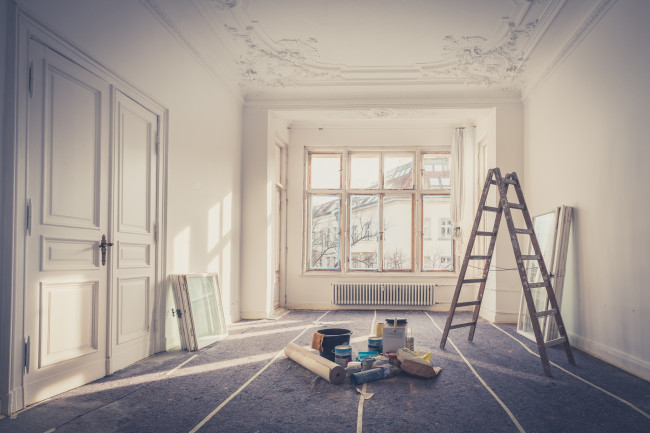What to consider when buying an estate-condition apartment in need of a gut renovation

iStock
Thanks to New York City’s vast landscape of historically significant, pre-war co-ops, condos, and brownstones, buyers are likely to encounter a bevy of properties in “estate condition” during their search for the perfect home. Simply put, estate condition homes are properties in which the original owner has passed away, and the owner’s heirs are charged with selling the unoccupied space as-is. However, like many real estate definitions, there’s some wiggle room here. Often brokers and sellers will use the term “estate condition” somewhat loosely, occasionally referring to properties that are simply older and have not been renovated in the last several decades.
Many estate condition homes are true diamonds in the rough in NYC and a gut renovation can help restore the properties to their former glory while considering the needs of families today.
“Our mission is to help homeowners transform their home by empowering them with the information they need at the right time, and by taking the risk away from the renovation process,” says Anna Karp, co-founder of Bolster, a New York City design and build company that helps homeowners to control their major renovation by delivering industry-leading expertise and a radically transparent process. “New York City has historically important and beautiful homes and buildings, and our team understands their origin, history and how to adapt them to any specific needs.”
If you have your sights set on buying and renovating an estate condition home, read on for a few things to keep in mind–pre-sale and during renovation planning.
Whether you're renovating a two-bedroom prewar co-op or a 4,000-square-foot brownstone, Bolster guarantees a beautifully designed home renovation risk-free and on-budget. "Expect flawless communication, white-glove service, and absolutely no surprise costs," says Bolster's CEO and co-founder Anna Karp. Ready to start your renovation? Learn more >>
Interesting old details
As the old saying goes, they just don’t make them like they used to. Such is the case for certain details and fixtures of bygone eras. Many homeowners choose to maintain these elements in order to preserve the historic integrity–and value–of the home.
“Some estate sale homes have lovely old plumbing fixtures: faucets and tubs, beautiful plaster crowns, finely detailed steel windows or doors which would be hard to replicate now,” says Bolster architect Michael Fasulo. “I once encountered a toe tester in a shower, which was a little faucet that poured water into the shower so you could check the temperature before stepping in. We had it cleaned up, re-plated with nickel and installed in a new shower as an homage to the apartment’s history.”
Parting with the past
As mentioned, “estate sale” can be broker code for any older apartment, regardless of the true genealogy of the home. But when you’re dealing with sellers in a time of grief, emotions can run high.
“Sometimes you’ll find a true estate where the heirs have an emotional attachment to the place,” says Michael. “This can make aspects of the transaction difficult as the heirs come to terms with the sale.”
Infrastructure upgrades
An unaltered estate-condition home will have original plumbing, telephone and electric components in place and no central AC. If you’re buying with the intention to renovate, these systems will most likely need to be replaced to comply with building management and building department rules.
“If your intention is to buy and renovate, estate sales are a great place to start because the cost of someone else’s renovation won’t be included in your price tag,” says Michael.
Reduced purchase price
As traditional renovation processes are murky and pricing can be all over the map, homebuyers often don’t understand what the total cost of a proper gut renovation could–or should–total to, based on the condition of the home. However, when homebuyers perceive a higher price point for a gut renovation, this can work to reduce the purchase price of the home–it’s a bargaining point.
“This doesn’t always hold true in highly desirable zip codes,” cautions Michael. “In some areas, the location value is just too high to come down on asking price.”
Board approvals
When an apartment is in original condition, or hasn’t been renovated in many years, boards are frequently more lenient when considering renovation applications, as it will add value to the entire building. “A board may take the renovation as an opportunity to have old plumbing risers replaced, in order to strengthen the integrity of the infrastructure,” says Michael. “It’s in the board’s best interest to ensure homes in the building are up-to-code and renovated beautifully.”
“An integral part of the Bolster process is to work in tandem with co-op and condo boards in order to, in as much as possible, sail through building regulations, file the correct permits, and ensure total project compliance, which is seminal to the Bolster model,” adds Anna.
Every year, New Yorkers waste over $700M following the usual renovation process.
Bolster has uncovered the drivers behind these inefficiencies and has developed a proprietary solution that applies to every home renovation project. Bolster is the first company to bring radical transparency, analytics, and accountability to the entire process. They promise that every project is thoughtfully designed and beautifully delivered for a fair price, on time, and on budget. To start your major home renovation project, visit bolster.us
You Might Also Like



























